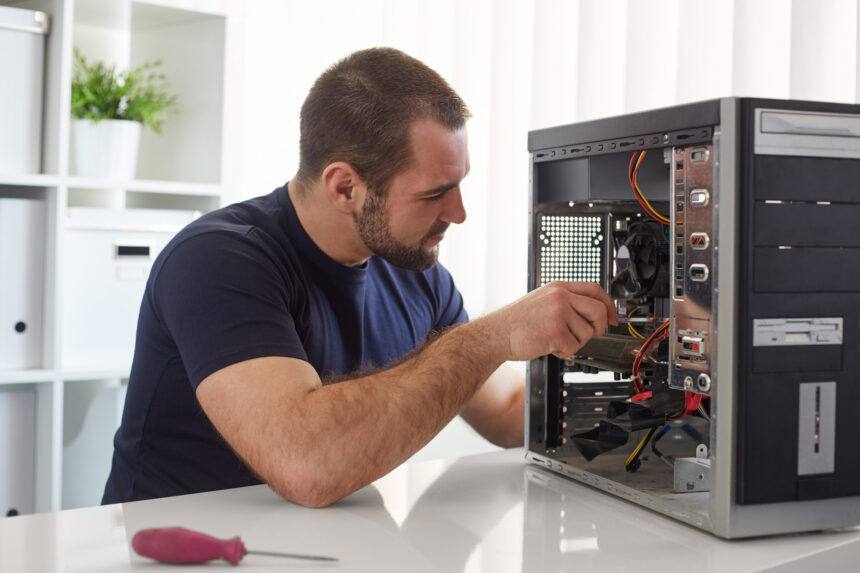Are you a computer repair business owner struggling to make it big in the market?
It’s understandable that the repair industry is unforgiving and puts you through various challenges. After all, technology is evolving continuously and so are customer expectations.
So, even when your technicians have the necessary skills, you need more than that to take the top spot. One of the ways you can do this is by investing in computer repair shop software, which allows you to confront efficiency challenges head-on. Here, we look at the challenges faced by computer repair stores and how you can use technology to provide outstanding service.
The Effects of Quick Technological Developments
The speed at which technology is developing in the digital age is unstoppable. Now and then, new hardware and operating systems are released, each having specific hardware and software requirements. It might be difficult for a computer repair company to keep up with these advancements. Without ongoing education, technicians risk being out of date and unable to identify or resolve issues with the newest gadgets.
Furthermore, repairs are more difficult due to the intricacy of contemporary computers, cell phones, and tablets. While component-level repairs were possible with older systems, more sophisticated, integrated designs are often seen in more recent models. Many businesses are adopting designs that make repairs more difficult, sometimes on purpose, notably in the consumer electronics market. If repairs are not feasible or economical, this may result in disgruntled technicians and missed business prospects.
Getting Past This Obstacle
Making continual education investments is crucial to addressing these problems. To stay current on the newest technology and repair methods, technicians need to take training courses and certification exams. Creating alliances with manufacturers and independent providers of repair components can also make necessary tools and parts accessible. Entrepreneurs can set themselves apart by focusing on particular brands or categories of repairs. Concentrating on specialized fields with less competition can aid in creating knowledge that is valued by clients.
Also, here’s a comparison of the best POS systems for your repair business.
DIY solutions and Big Tech competition
The increasing rivalry between major IT companies and do-it-yourself repair options presents another challenge for small computer repair organizations. These days, major manufacturers like Apple, Dell, and HP provide their repair services, frequently combining them with customer assistance and product warranties. Even while independent repair shops can provide more reasonable solutions, customers who purchase extended warranties might want to use these services.
Apart from big tech, another concern is the growing DIY repair culture, which is powered by widely available components and internet guides. A growing number of consumers are trying to fix their electronics instead of hiring experts. While tech-savvy people benefit from this, repair firms lose out on potential customers, particularly for simple fixes.
How to Handle this?
Businesses that repair computers must highlight the advantages of hiring professionals if they want to compete. Expert technicians contribute knowledge beyond what may be acquired from a YouTube tutorial. A professional business might stand out by emphasizing its quicker turnaround times, warranties on repairs, and higher caliber of work. Trust and loyalty can also be developed by providing outstanding customer service and informing customers about the dangers of doing repairs on their own.
Businesses can also think about providing value-added services like data recovery, device optimization, and preventive maintenance. These services frequently offer benefits above big tech or do-it-yourself solutions, creating new revenue streams and motivating clients to hire professionals.
Shorter Device Lifespans and a Culture of Disposable Technology
Consumer gadgets used to last much longer, but in recent years, this has drastically dropped, and many goods are now made with obsolescence in mind. Manufacturers may push customers to replace their equipment rather than repair them, as device repair is getting harder and harder. Repair shops thus face dwindling prospects as customers choose replacement over repair.
A further consequence of this disposable technology culture is a decline in consumer interest in long-term gadget maintenance. Long-lasting computers, tablets, and cell phones are now replaced every one to three years. As consumers emphasize making new purchases over updating outdated technology, this trend has an impact on the demand for repair services.
Getting Past This Obstacle
Dividing services is an additional strategy. Repair shops can increase their market share by going beyond repairs and providing trade-in programs, reconditioned gadgets, or even new device sales. With this strategy, the company can adapt to changing client preferences and stay competitive in the repair market.
Key Takeaways
Although there are difficulties in the modern computer repair industry, these difficulties are not insurmountable. You can establish a solid business reputation by providing high-quality service, staying updated with technology advancements, and taking care of your customers’ needs. In an industry that is evolving quickly, companies can remain relevant by concentrating on sustainability and broadening their offerings.







